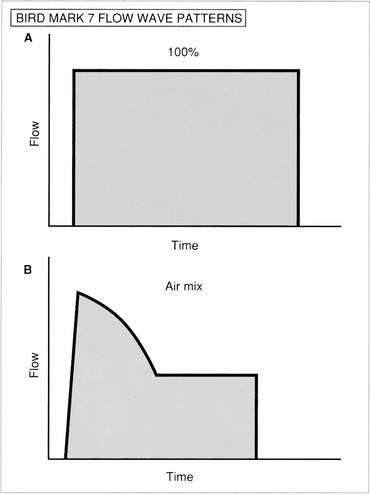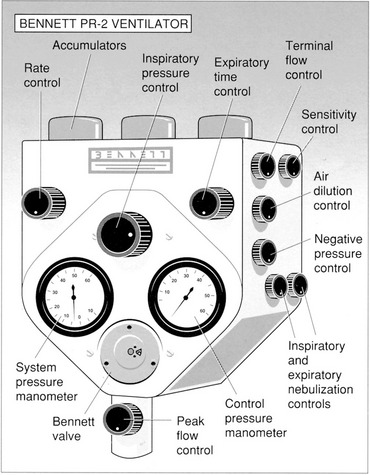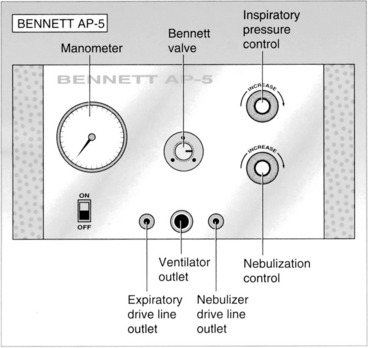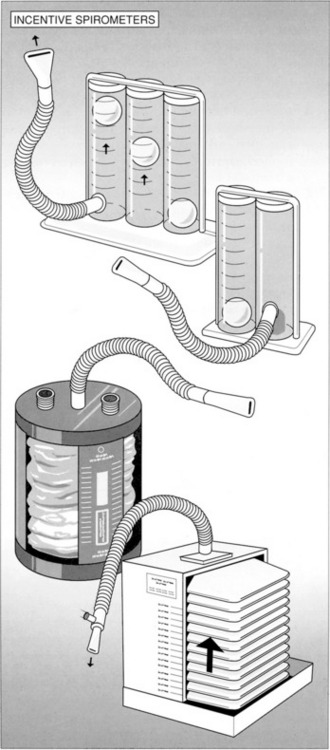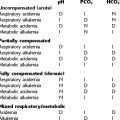CHAPTER 7 HYPERINFLATION THERAPY
PRETEST QUESTIONS
1. Which of the following increases the delivered VT to a patient taking an IPPB treatment with the Bird Mark 7 IPPB machine?
2. During an IPPB treatment, the patient suddenly complains of chest pain and becomes short of breath. On assessing the patient, you auscultate the chest and hear decreased breath sounds on the left. These findings are consistent with which of the following?
3. The respiratory therapist is administering IPPB, and the patient complains of feeling light-headed and dizzy. What should the therapist do to correct this?
4. While the respiratory therapist is administering IPPB, the patient begins coughing up large amounts of blood. The therapist should
5. Which of the following are hazards of IPPB therapy?
6. The respiratory therapist has received an order to deliver IPPB to a patient with head trauma. What modifications in therapy may benefit this patient?
7. Incentive spirometry is ordered for a patient after abdominal surgery. Which of the following statements by the respiratory care practitioner would be most appropriate in the initial explanation of the therapy to the patient?
8. Sustained maximal inspiratory maneuvers performed with an incentive spirometer would be MOST effective in the
9. The initial inspiratory goal for a patient receiving incentive spirometry should be
REVIEW
I. INTRODUCTION TO IPPB THERAPY
CRT Exam Content Matrix: IIA6a, IIA11b, IIB5, IIIA1a-b, IIID2a, IIIF1, IIIF2a
RRT Exam Content Matrix: IIA2a, IIIA1a-b, IIID2a, IIIF1, IIIF2a
II. PHYSIOLOGIC EFFECTS OF IPPB
III. INDICATIONS FOR IPPB THERAPY
V. CONTRAINDICATIONS TO IPPB THERAPY
VI. POSITIVE EFFECTS OF IPPB IN THE TREATMENT OF PULMONARY EDEMA
![]() Exam Note
Exam Note
Ethanol is seldom used clinically, but questions regarding its use may appear on the exam.
VII. PROPER ADMINISTRATION OF IPPB
![]() Exam Note
Exam Note
If the pulse rate increases more than 20 beats/min, stop treatment and notify the physician.
VIII. CHARACTERISTICS OF SPECIFIC IPPB UNITS
IX. FACTORS TO CONSIDER WHEN USING A PRESSURE-LIMITED IPPB MACHINE
X. PROBLEMS WITH IPPB AND CORRECTIVE ACTIONS
XI. INCENTIVE SPIROMETRY (SUSTAINED MAXIMAL INSPIRATORY THERAPY)
CRT Exam Content Matrix: IIA13, IIID1a-b, IIIF2b
RRT Exam Content Matrix: IIID1, IIIF2b
POSTCHAPTER STUDY QUESTIONS
1. List five physiologic effects of IPPB.
2. List seven indications for IPPB.
3. List eight hazards of IPPB.
4. List two absolute contraindications to IPPB.
5. The pulse rate must not exceed how many beats/min before the treatment must be terminated?
6. What effect does an increased airway resistance have on delivered VT on a pressure-limited IPPB machine?
7. What effect does an increased lung compliance have on the delivered VT on a pressure-limited IPPB machine?
8. How does a decreased lung compliance affect inspiratory time?
9. List ways to help correct a situation in which the patient has difficulty cycling the IPPB machine into the expiratory phase.
10. How should an IPPB treatment be modified for a patient with a closed head injury?
11. Incentive spirometry is indicated if a patient can obtain a vital capacity of what level?
12. What is another term used for incentive spirometry?
13. List three requirements necessary for incentive spirometry to be effective.


